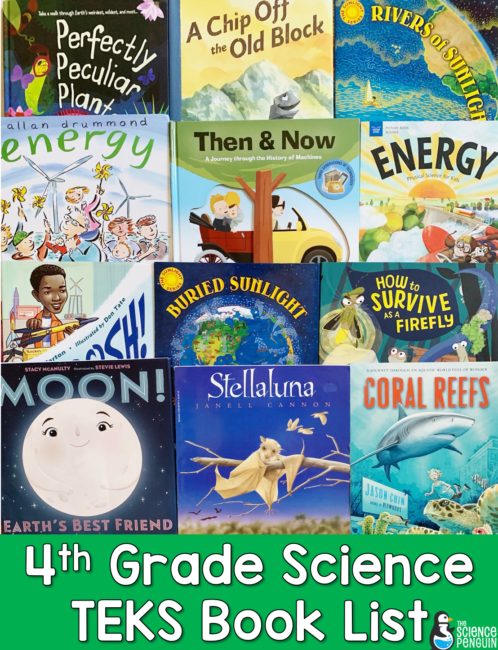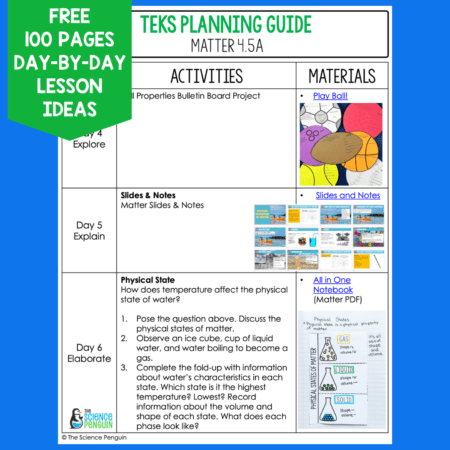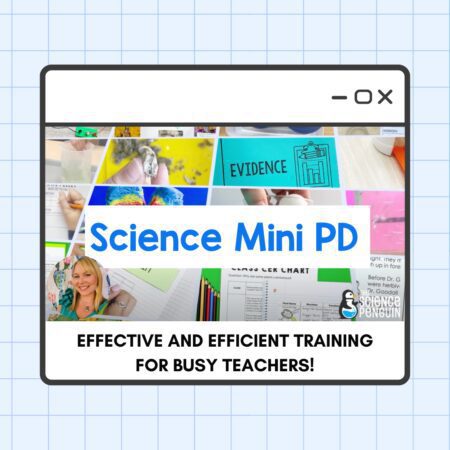
One of my favorite ways to address the 4th grade science TEKS all year long while also inspiring students is through read-alouds and a robust classroom library. It’s important to make sure representation is diverse and many interesting careers and historical stories are mentioned.
This list features affiliate links.
Category 1: Matter and Energy
4.5 The student knows that matter has measurable physical properties and those properties determine how matter is classified, changed, and used. The student is expected to:
4.5A measure, compare, and contrast physical properties of matter, including mass, volume, states (solid, liquid, gas), temperature, magnetism, and the ability to sink or float
Curious Pearl Explains States of Matter
Mario and the Hole in the Sky: How a Chemist Saved Our Planet
What’s the Matter in Mr. Whiskers’ Room?
Matter: Physical Science for Kids
4.5B compare and contrast a variety of mixtures, including solutions
Category 2: Force, Motion, and Energy
4.6 The student knows that energy exists in many forms and can be observed in cycles, patterns, and systems. The student is expected to:
4.6A differentiate among forms of energy, including mechanical, sound, electrical, light, and thermal
Energy: Physical Science for Kids
Then and Now: A Journey Through the History of Machines
Burn: Michael Faraday’s Candle
Whoosh: Lonnie Johnson’s Super Soaking Stream of Inventions
Clang: Ernst Chladni’s Sound Experiment
4.6B differentiate between conductors and insulators of thermal and electrical energy
I have not come across any good books for this particular SE.
4.6C demonstrate that electricity travels in a closed path, creating an electrical circuit
Electrical Wizard: How Nikola Tesla Lit Up the World
You Wouldn’t Want to Live Without Electricity
4.6D design a descriptive investigation to explore the effect of force on an object such as a push or a pull, gravity, friction, or magnetism
Curious Pearl Kicks Off Force and Motion
The Marvelous Thing That Came From a Spring
Category 3: Earth and Space
4.7 The students know that Earth consists of useful resources and its surface is constantly changing. The student is expected to:
4.7A examine properties of soils, including color and texture, capacity to retain water, and ability to support the growth of plants
You Wouldn’t Want to Live Without Dirt
4.7B observe and identify slow changes to Earth’s surface caused by weathering, erosion, and deposition from water, wind, and ice
Cracking Up: A Story About Erosion
4.7C identify and classify Earth’s renewable resources, including air, plants, water, and animals, and nonrenewable resources, including coal, oil, and natural gas, and the importance of conservation
Buried Sunlight: How Fossil Fuels Have Changed the Earth
4.8 The student knows that there are recognizable patterns in the natural world and among the Sun, Earth, and Moon system. The student is expected to:
4.8A measure, record, and predict changes in weather
Meteorology and Forecasting the Weather
4.8B describe and illustrate the continuous movement of water above and on the surface of Earth through the water cycle and explain the role of the Sun as a major source of energy in this process
Water: National Geographic Kids
4.8C collect and analyze data to identify sequences and predict patterns of change in shadows, seasons, and the observable appearance of the Moon over time
Aerospace Engineer Aprille Ericsson
Scott Kelly: My Journey to the Stars
Category 4: Organisms and Environments
4.9 The student knows and understands that living organisms within an ecosystem interact with one another and with their environment. The student is expected to:
4.9A investigate that most producers need sunlight, water, and carbon dioxide to make their own food, while consumers are dependent on other organisms for food
4.9B describe the flow of energy through food webs, beginning with the Sun, and predict how changes in the ecosystem affect the food web
4.10 The student knows that organisms undergo similar life processes and have structures and behaviors that help them survive within their environment. The student is expected to:
4.10A explore how structures and functions enable organisms to survive in their environment
Bone by Bone: Comparing Animal Skeletons
Manfish: A Story of Jacques Cousteau
4.10B explore and describe examples of traits that are inherited from parents to offspring such as eye color and shapes of leaves and behaviors that are learned such as reading a book and a wolf pack teaching their pups to hunt effectively
Inheritance of Traits: Why is My Dog Bigger Than Your Dog?
4.10C explore, illustrate, and compare life cycles in living organisms such as beetles, crickets, radishes, or lima beans
4th Grade Science TEKS Classroom Resources
See how we can help make science class the best part of your day! Click to see how!
FREE 4th Grade Science TEKS Planning Guide
A strong focus on vocabulary, hands-on experiences, and claim writing will set your students up for success!
Because we offer so many materials and ideas for the 4th grade Science TEKS on The Science Penguin, I decided to help teachers by making free planning guides for each unit.
Not quite sure where to start when it comes to teaching the 4th grade science TEKS? We’ve got you covered with this 100-page guide with day-by-day activity suggestions to accompany your Science Penguin resources. Lesson planning just got easier!
Sign up now to access the Free 4th Grade Science TEKS Planning Guide!
Enter your personal email so your resource doesn’t get stuck in a district filter!








3 thoughts on “The Ultimate 4th Grade Science TEKS Book List”
Could this book list also be used with 3rd graders?
For sure!
Thank you for this list of books. My niece is about to get a surplus of science topics under the tree.